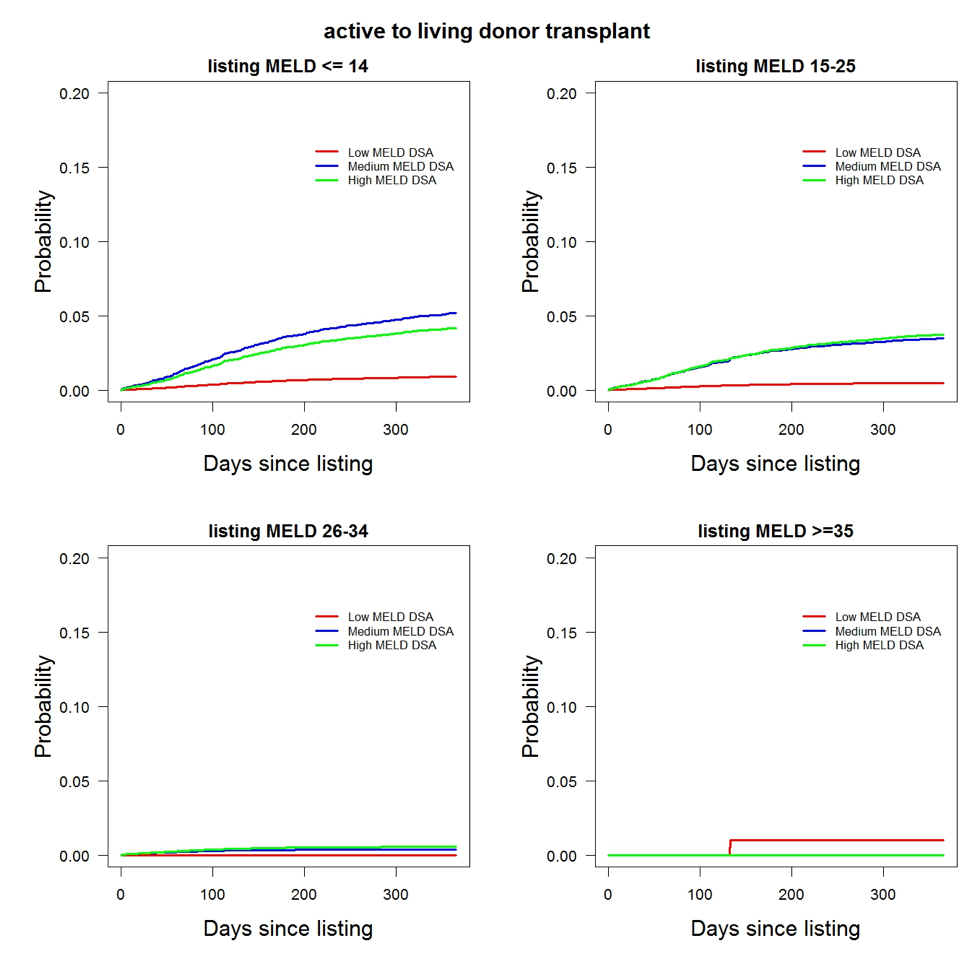Higher Probability of Living Donor Liver Transplantation is Associated with DSAs Having a Higher Median Meld at Transplant
D. Haakinson1, S. Noreen2, D. Stewart2, R. Batra1, G. Gan1, Y. Deng1, S. Kulkarni1
1Yale, New Haven, CT, 2UNOS, Richmond, VA
Meeting: 2020 American Transplant Congress
Abstract number: B-164
Keywords: Liver transplantation, Living-related liver donors, Waiting lists
Session Information
Session Name: Poster Session B: Liver: Living Donors and Partial Grafts
Session Type: Poster Session
Date: Saturday, May 30, 2020
Session Time: 3:15pm-4:00pm
 Presentation Time: 3:30pm-4:00pm
Presentation Time: 3:30pm-4:00pm
Location: Virtual
*Purpose: Recent studies show that outcomes of living donor liver transplantation (LDLT) are superior compared to those receiving deceased donor grafts. Access to deceased donor liver grafts for lower model for end-stage liver disease (MELD) patients is known to differ geographically. The association of access to LDLT based on Donation Service Area (DSA) and MELD score has yet to be quantified.
*Methods: We constructed a semi-parametric multistate model using the OPTN database (06/18/2013 to 06/08/2018) to calculate the probability of the following competing events for liver transplant candidates: deceased donor transplant, living donor transplant, death, or other/well. Status 1 and MELD exception patients were excluded. We grouped DSAs by their median MELD at transplant (MMaT) and separated them into tertiles (low, medium, high MMaT). Following an active listing, we measured the probability of LDLT stratified by patient MELD categories (MELD < 14, 15-24, 25-34, >35). We adjusted this model for known covariates.
*Results: There were 25,216 adult patients, of which 98.5% were listed as active. During the study period, living donor transplants comprised 5% of total liver transplants. Mean time to a LDLT was 194.4 days (±204.4) for individuals never experiencing an inactive status change. For individuals who experienced at least one inactive status change, time to transplant increased to a mean of 276.8 days (±267.5). The highest probability of receiving a living donor transplant was in the <14 MELD and MELD 15-25 categories, and in DSA’s with a high or medium MMaT (Figure). There were no statistically significant differences in the one-year probability of living donor transplant in initial MELD categories of 26-34 and >35.
*Conclusions: Access to LDLT differs significantly between a DSAs grouped by MMaT in lower MELD patients, and a period of inactivity significantly impacts the mean time to transplant. Given the superior outcomes of transplants from a living donor, transplant centers in areas with lower MMaT should consider improving access to LDLT.
To cite this abstract in AMA style:
Haakinson D, Noreen S, Stewart D, Batra R, Gan G, Deng Y, Kulkarni S. Higher Probability of Living Donor Liver Transplantation is Associated with DSAs Having a Higher Median Meld at Transplant [abstract]. Am J Transplant. 2020; 20 (suppl 3). https://atcmeetingabstracts.com/abstract/higher-probability-of-living-donor-liver-transplantation-is-associated-with-dsas-having-a-higher-median-meld-at-transplant/. Accessed December 18, 2025.« Back to 2020 American Transplant Congress

